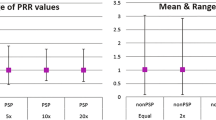Abstract
Background: Disproportionality analysis of spontaneous reporting is increasingly used, but it may be influenced in unknown ways by safety alerts (notoriety bias).
Objective: To explore the consequences of safety alerts on reporting disproportionality.
Methods: Within the French national pharmacovigilance database, disproportionality of reporting was tested, using the reporting odds ratio (ROR) and its 95% confidence interval, before and after four safety alerts: valvulopathies with pergolide; tuberculosis with infliximab; strokes with atypical antipsychotics; and rhabdomyolysis with HMG-CoA reductase inhibitors (statins) [after cerivastatin withdrawal].
Results: No cases of valvulopathy were reported in association with pergolide before the safety alert and 63 cases were reported after the alert, (ROR 9400; 95% CI4300, 20 000), of which five had occurred before the alert. Twenty-five reports mentioned rhabdomyolysis associated with statins (not including cerivastatin) before the safety alert (ROR 5.8; 95% CI 3.8, 9.0), and 63 did so after the alert (ROR 9.4; 95% CI 7.0, 13.0). Approximately 280 cases involving cerivastatin were reported after its withdrawal. There were two reports of tuberculosis associated with infliximab before the alert (ROR 1500; 95% CI 130, 18 000) and seven after the alert (ROR 430; 95% CI 110, 1700). There was one report of a stroke in association with atypical antipsychotic treatment before the safety alert (ROR 0.10; 95% CI 0.01, 0.63) and 16 after the alert (ROR 1.10; 95% CI 0.70, 1.90). After excluding events involving treatment with anticoagulant agents, the RORs for stroke in association with atypical antipsychotic treatment were 0.14 (95% CI 0.02, 1.00) before the alert and 2.0 (95% CI 1.2, 3.4) after the alert.
Conclusion: Disproportionality in spontaneous reporting databases increases after a safety alert because of increased reporting of the event of interest, including reports of such events that occurred before the alert. This may overflow to increased reporting of the event in association with other drugs.






Similar content being viewed by others
References
Bate A, Lindquist M, Edwards IR, et al. A Bayesian neural network method for adverse drug reaction signal generation. Eur J Clin Pharmacol 1998; 54(4): 315–21
Evans SJ, Waller PC, Davis S. Use of proportional reporting ratios (PRRs) for signal generation from spontaneous adverse drug reaction reports. Pharmacoepidemiol Drug Saf 2001; 10(6): 483–6
Roux E, Thiessard F, Fourrier A, et al. Evaluation of statistical association measures for the automatic signal generation in pharmacovigilance. IEEE Trans Inf Technol Biomed 2005; 9(4): 518–27
van Puijenbroek EP, Bate A, Leufkens HG, et al. A comparison of measures of disproportionality for signal detection in spontaneous reporting systems for adverse drug reactions. Pharmacoepidemiol Drug Saf 2002; 11(1): 3–10
Waller PC, Coulson RA, Wood SM. Regulatory pharmacovigilance in the United Kingdom: current principles and practice. Pharmacoepidemiol Drug Saf 1996; 5(6): 363–75
Moore N, Kreft-Jais C, Haramburu F, et al. Reports of hypoglycaemia associated with the use of ACE inhibitors and other drugs: a case/non-case study in the French pharmacovigilance system database. Br J Clin Pharmacol 1997; 44(5): 513–8
Rothman KJ, Lanes S, Sacks ST. The reporting odds ratio and its advantages over the proportional reporting ratio. Pharmacoepidemiol Drug Saf 2004; 13(8): 519–23
Moore N, Hall G, Sturkenboom M, et al. Biases affecting the proportional reporting ratio (PPR) in spontaneous reports pharmacovigilance databases: the example of sertindole. Pharmacoepidemiol Drug Saf 2003; 12(4): 271–81
Hauben M, Reich L, Van Puijenbroek EP, et al. Data mining in pharmacovigilance: lessons from phantom ships. Eur J Clin Pharmacol 2006; 62(11): 967–70
Stephenson WP, Hauben M. Data mining for signals in spontaneous reporting databases: proceed with caution. Pharmacoepidemiol Drug Saf 2007; 16(4): 359–65
Strom LB. Pharmacoepidemiology. 4th ed. Chichester: Wiley, 2005
van Puijenbroek EP, van Grootheest K, Diemont WL, et al. Determinants of signal selection in a spontaneous reporting system for adverse drug reactions. Br J Clin Pharmacol 2001; 52(5): 579–86
Begaud B. Dictionary of pharmacoepidemiology. Chichester: John Wiley & sons, 2000
Communiqué de presse: REMICADE® (infliximab)/Tuberculose. 2000 Dec 28. Agence Française de Sécurité Sanitaire des Produits de Sante [online]. Available from URL: http://afssaps.sante.fr/htm/10/filcoprs/indcompr.htm [Accessed 2007 Aug 9]
Mac Carty EP, for Bayer Corporation. Market withdrawal of Baycol® (cerivastatin). 2001 Aug 8. US FDA [online]. Available from URL: http://www.fda.gov/medWatch/safety/2001/Baycol2.htm [Accessed 2007 Aug 9]
Ravoire S, for Lilly France. Information importante de pharmacovigilance Celance® (pergolide). Agence Française de Sécurité Sanitaire des Produits de Santé [online]. Available on URL: http://agmed.sante.gouv.fr/htm/10/filcoprs/041102.htm [Accessed 2007 Aug 9]
Communiqué de presse: Sécurité d’emploi des neuroleptiques chez les patients âgés atteints de démence. 2004 Mar 9. Agence Française de Sécurité Sanitaire des Produits de Santé [online]. Available from URL: http://afssaps.sante.fr/htm/10/filcoprs/indcompr.htm [Accessed 2007 Aug 9]
Brodaty H, Ames D, Snowdon J, et al. A randomized placebo-controlled trial of risperidone for the treatment of aggression, agitation, and psychosis of dementia. J Clin Psychiatry 2003; 64(2): 134–43
Wooltorton E. Olanzapine (Zyprexa): increased incidence of cerebrovascular events in dementia trials. CMAJ 2004; 170(9): 1395
Moore N, Biour M, Paux G, et al. Adverse drug reaction monitoring: doing it the French way. Lancet 1985; 2(8463): 1056–8
Moore N, Noblet C, Kreft-Jais C, et al. French pharmacovigilance database system: examples of utilisation [in French]. Therapie 1995; 50(6): 557–62
Kramer M. Clinical epidemiology and biostatistics. Berlin: Springer Verlag, 1988
Griffin JP, Weber JC. Voluntary systems of adverse reaction reporting — part I. Adverse Drug React Acute Poisoning Rev 1985; 4(4): 213–30
Acknowledgements
The French Pharmacovigilance Database was established and is maintained by the French Pharmacovigilance System. No funding was provided specifically to assist in the preparation of this study. The investigators who conducted this study were employed by the Universite de Bordeaux and/or the CHU de Bordeaux. The study was performed as part of their regular work schedule and was part of their statutory activities.
The authors have no conflicts of interest that are directly relevant to the content of this study.
Author information
Authors and Affiliations
Corresponding author
Rights and permissions
About this article
Cite this article
Pariente, A., Gregoire, F., Fourrier-Reglat, A. et al. Impact of Safety Alerts on Measures of Disproportionality in Spontaneous Reporting Databases The Notoriety Bias. Drug-Safety 30, 891–898 (2007). https://doi.org/10.2165/00002018-200730100-00007
Published:
Issue Date:
DOI: https://doi.org/10.2165/00002018-200730100-00007




